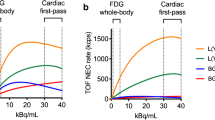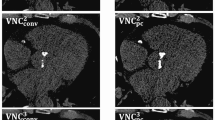Abstract
At present, 3-D reconstructions of coronary vessels are generated from intravascular ultrasound (IVUS) by stacking up ECG-gated segmented IVUS frames of a pullback sequence. This simplified approach always results in straight vessel reconstructions and, therefore, gives an incorrect representation of tortuous coronary arteries. A more realistic reconstruction of tortuous vessels may be obtained by data fusion with biplane angiography. The 3-D course of the vessel is first derived from the angiograms and then combined with the segmented IVUS images. In this paper, we focus on two problems associated with the data fusion method: The definition of the pullback path and the estimation of the IVUS catheter twist during pullback. A robust algorithm for calculation of tortuosity-induced catheter twist is reported that is based on sequential triangulation of the 3-D pullback path. The method is analyzed with computer simulations and validated in helical vessel phantoms. A largely automated data fusion approach is proposed and applied to tortuous coronary arteries in cadaveric pig hearts.
Similar content being viewed by others
References
Brown BG, Bolson E, Frimer M, Dodge H. Quantitative coronary arteriography. Estimation of dimensions, hemodynamic resistance, and atheroma mass of coronary artery lesions using the arteriogram and digital computation. Circulation 1977; 55: 329–37.
Reiber JHC, Kooijman CJ, Slager CJ, Gerbrands JJ, Schuurbiers JHC, den Boer A, et al. Coronary artery dimensions from cineangiograms — Methodology and validation of a computer-assisted analysis procedure. IEEE Trans Med Imag 1984; 3: 131–41.
Büchi M, Hess OM, Kirkeeide RL, Suter T, Muser M, Osenberg HP, et al. Validation of a new automatic system for biplane coronary arteriography. Int J Card Imag 1990; 5: 93–103.
Sonka M, Winniford MD, Collins SM. Robust simultaneous detection of coronary borders in complex images. IEEE Trans Med Imag 1995; 14(1): 151–61.
Herrington DM, Johnson T, Santago P, Snyder, WE. Semiautomated boundary detection for intravascular ultrasound. In: Proc. Conf. Computers in Cardiology; 1992 Oct 11–14; Durham (NC). Los Alamitos (CA): IEEE 1992: 103–6.
Li W, von Birgelen C, Di Mario C, Boersma E, Gussenhoven EJ, van der Putten N, N Bom N. Semi-automatic contour detection for volumetric quantification of intracoronary ultrasound. In: Proc. Conf. Computers in Cardiology; 1994 Sep 25–28; Bethesda (MD). Los Alamitos (CA): IEEE 1994: 277–280.
Sonka M, Zhang X, Siebes M, Bissing MS, DeJong SC, Collins SM, McKay CR. Segmentation of intravascular ultrasound images: a knowledge-based approach. IEEE Trans Med Imag 1995; 14(4): 719–32.
Parker DL, Pope DL, van Bree R, Marshall H. Three-dimensional reconstruction of moving arterial beds from digital subtraction angiography. Comp Biomed Res 1987; 20: 166–85.
Kitamura K, Tobis JM, Sklansky J. Estimating the 3-D skeletons and transverse areas of coronary arteries from biplane angiograms. IEEE Trans Med Imag 1988; 7(3): 173–87.
Guggenheim N, Doriot PA, Dorsaz PA, Descouts P, Rutishauser W. Spatial reconstruction of coronary arteries from angiographic images. Phys Med Biol 1991; 36(1): 99–110.
Wahle A, Wellnhofer E, Mugaragu I, Sauer HU, Oswald H, Fleck E. Assessment of diffuse artery disease by quantitative analysis of coronary morphology based upon 3-D reconstruction from biplane angiograms. IEEE Trans Med Imag 1995; 14(2): 230–41.
Van Tran L, Bahn RC, Sklansky J. Reconstructing the cross sections of coronary arteries from biplane angiograms. IEEE Trans Med Imag 1992; 11(4): 517–29.
Roelandt JRTC, Di Mario C, Pandian NG, Li W, Keane D, Slager CJ, et al. Three-dimensional reconstruction of intra-coronary ultrasound images: rationale, approaches, problems, and directions. Circulation 1994; 90(2): 1044–55.
Laban M, Oomen JA, Slager CJ, Wentzel JJ, Krams R, Schuurbiers JHC, et al. ANGUS: a new approach to three-dimensional reconstruction of coronary vessels by combined use of angiography and intravascular ultrasound. In: Proc Conf Computers in Cardiology; 1995 Sep 10–13; Vienna. Piscataway (NJ): IEEE 1995: 325–8.
Evans JL, Ng KH, Wiet SG, Vonesh MJ, Burns WB, Radvany MG, et al. Accurate three-dimensional reconstruction of intravascular ultrasound data — spatially correct three-dimensional reconstructions. Circulation 1996; 93(3): 567–76.
Prause GPM, DeJong SC, McKay CR, Sonka M. Semiautomated segmentation and 3-D reconstruction of coronary trees: biplane angiography and intravascular ultrasound data fusion. In: Hoffman EA, editor. Physiology and Function from Multidimensional Images. Proc Conf Medical Imaging; 1996 Feb 11–15; Newport Beach (CA). Bellingham (WA): SPIE 1996; 2709: 82–92.
Shekhar R, Cothren RM, Vince DG, Cornhill JF. Fusion of intravascular ultrasound and biplane angiography for three-dimensional reconstruction of coronary arteries. In: Proc Conf Computers in Cardiology; 1996 Sep 8–11; Indianapolis (IN). Piscataway (NJ): IEEE 1996: 5–8.
Prause GPM, DeJong SC, McKay CR, Sonka M. Geometrically correct 3-D reconstruction of coronary wall and plaque: combining biplane angiography and intravascular ultrasound. In: Proc Conf Computers in Cardiology; 1996 Sep 8–11; Indianapolis (IN). Piscataway (NJ): IEEE 1996: 325–8.
ten Hoff H, Korbijn A, Smith TH, Klinkhamer JF, Bom N. Imaging artifacts in mechanically driven ultrasound catheters. Int J Card Imag 1989; 4: 195–9.
Kimura BJ, Bhargava V, Palinski W, Russo RJ, DeMaria AN. Distortion of intravascular ultrasound images because of nonuniform angular velocity of mechanical type transducers. Am Heart J 1996; 132: 328–36.
Bruining N, von Birgelen C, de Vrey E, Nicosia A, Li W, Prati F, et al. ECG-gated ICUS image acquisition combined with a semi-automated contour detection provides accurate analysis of vessel dimensions. In: Proc Conf Computers in Cardiology; 1996 Sep 8–11; Indianapolis (IN). Piscataway (NJ): IEEE 1996: 53–6.
O'Neill B. Elementary Differential Geometry. Academic Press, New York, 1966.
Prause GPM, Onnasch DGW. Binary reconstruction of the heart chambers from biplane angiographic image sequences. IEEE Trans Med Imag 1996; 15(4): 532–46.
Author information
Authors and Affiliations
Rights and permissions
About this article
Cite this article
Prause, G.P., DeJong, S.C., McKay, C.R. et al. Towards a geometrically correct 3-D reconstruction of tortuous coronary arteries based on biplane angiography and intravascular ultrasound. Int J Cardiovasc Imaging 13, 451–462 (1997). https://doi.org/10.1023/A:1005843222820
Issue Date:
DOI: https://doi.org/10.1023/A:1005843222820




